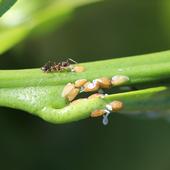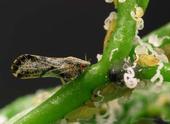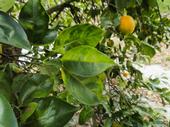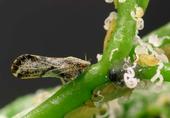- Author: Elizabeth E Grafton-Cardwell
- Editor: Elaine Lander

[This post has been modified from the article originally published in the Fall 2018 issue of the Retail Nursery and Garden Center IPM News.]
Most citrus tree problems in home gardens can be solved by pruning the trees to allow better air flow and by controlling ants. Ants collect the honeydew produced by Asian citrus psyllid nymphs, mealybugs and

The Asian citrus psyllid is an insect that can carry a deadly tree disease called Huanglongbing or citrus greening. To help educate people about the seriousness of this disease, how it spreads, and how to deal with it, the UC IPM program has published an updated version of the Pest Notes: Asian Citrus Psyllid and Huanglongbing Disease, by experts Elizabeth Grafton-Cardwell and Matt Daugherty.
- Author: Pamela Kan-Rice

The incurable citrus tree disease huanglongbing, or HLB, has been detected in Los Angeles and Orange counties and most recently in

[From the Summer issue of the UC IPM Retail Nursery & Garden Center News]
The incurable citrus disease huanglongbing (HLB) has been detected in dozens of backyard trees in Los Angeles and Orange counties and most recently in Riverside. The bacterium that causes this disease is spread from tree to tree by Asian citrus psyllids (Figure 1). HLB, also known as citrus greening, has already devastated the citrus trees in Florida, Georgia, Louisiana, South Carolina, and Texas. There is no known treatment for the disease, which usually kills the tree within three to five...
- Author: Elizabeth E Grafton-Cardwell
- Author: Matthew Daugherty
- Author: Cheryl A. Wilen
![Figure 1. Highly magnified adult Asian citrus psyllid feeding on citrus. [B. Grafton-Cardwell]](https://ucanr.edu/blogs/UCIPMurbanpests/blogfiles/35982small.jpg)
[From the March 2016 issue of UC IPM's Retail Nursery & Garden Center IPM News]
Asian citrus psyllid (ACP) continues to spread and to be an ever-present concern in California. Because of this, we have updated information from the April 2015 issue of UC IPM's Retail IPM newsletter to share with your customers.
Until 2013, ACP was mostly found in Southern California, but has since been found in multiple locations in the Central Valley and has been detected as far north as the San Francisco Bay Area. The psyllid is well-established in coastal and inland Southern California and it is slowly establishing itself in...


